Carefully crafted dialogue can make a big contribution to a piece of writing, especially a narrative. Of course, when it comes to punctuating speech in KS2, the key feature is the use of inverted commas. (These are also known as quotation marks or, less formally, speech marks).
However, we need to apply plenty of other rules and conventions when writing both direct and reported speech.
Below are a few tips to help your KS2 pupils get full marks when punctuating speech, but before you start, take a look at this excellent video, from our Teaching Tricky Grammar CPD series.
It features English consultant Rachel Clarke explaining how to develop children’s understanding and awareness of direct speech in the classroom.
Speech bubble – Know what’s being said
This may seem obvious, but it's important to make sure pupils are clear about what their characters are saying. It might help to do a little role-playing here to hammer the point home.
Find a short piece of dialogue from a book and act out the conversation using only the words shown in direct speech.
To seal the deal, repeat it with each character saying the reporting clause as well, just to show how silly it sounds.
The reporting clause
This is one of those situations where terminology can be particularly helpful. You can get really caught up talking about the bit that is spoken and the bit that isn’t spoken.
Referring to the latter as the reporting clause right from the outset can really emphasise the difference between the elements of a dialogue sentence.
What are speech marks/quotation marks?
Once pupils can effortlessly distinguish the dialogue from the reporting clauses, they need to demarcate it using inverted commas.
These can be a double mark in the ‘66 – 99’ style or simpler double lines. The most important point when punctuating speech in KS2 is that your marks are consistent and correctly placed.
It might be worth discussing single inverted commas (or a 'single quotation mark' or 'single marks' as they’re sometimes known). Eagle-eyed pupils will notice that many books use these instead of doubles.
Generally speaking, the way authors punctuate speech boils down to the ‘house style’ of the publisher. It's worth making sure that your school has a particular policy.
You might find doubles help to reduce confusion between inverted commas and other punctuation marks such as apostrophes.
This KS2 classroom display pack includes classroom display materials to help pupils in Years 3–4 understand, practise and display correct punctuation of direct speech using speech marks.
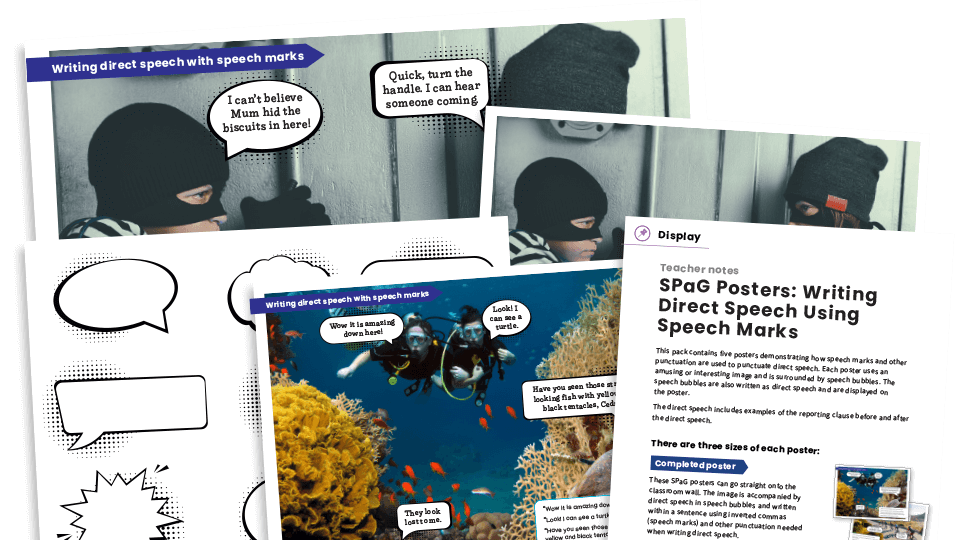
Where to use a capital letter when punctuating speech
Essentially, whenever you open up inverted commas, you need to capitalise the first word that follows. (We outline the only real exception to this in 'Splitting the speech/quote' below.)
This is true whether the reporting clause comes at the beginning or end of the sentence.
For example, the following sentence is correct:
“Put it there,” said Ash.
So is this one:
Ash said, “Put it there.”
Note also that the full stop goes inside the inverted commas when the speech follows the reporting clause.
You should also remember that you still require a capital to start each sentence if there is more than one in any passage of uninterrupted speech. For example:
Nisha said, “That is your pen. You chose the blue one. Mine is the black one.”
Commas when punctuating speech
As a general rule, where the reporting clause precedes the dialogue, you need a comma after the reporting clause but before you open the inverted commas.
Where the reporting clause follows the dialogue, you should insert a comma before the closing inverted commas, even if the dialogue contains a complete sentence (see the examples above). The exception is when the dialogue requires a special end mark.
Special end marks
This could cause a little confusion. Therefore it’s important to emphasise this point: when the dialogue requires a question mark or exclamation mark, we need to insert it before the closing inverted commas, even if the reporting clause comes at the end.
For example:
- “What are you doing?” Mum demanded.
- “Run away!” cried the knight.
Splitting the speech/quote
Placing the reporting clause in the middle of a section of speech can be really effective. By and large, all the punctuation rules above will apply. For example:
“That is so kind of you,” said Shay. “I had always wanted one of those.”
However, when the reporting clause interrupts a sentence, you don’t need a capital when you re-open the inverted commas. For example:
“If you drop your ice cream,” warned Dad, “you won’t get another.”
How to practise punctuating speech in KS2
Clearly, there is quite a lot for pupils to take in when it comes to writing direct speech. We expect them to know it by the end of Year 4.
This Year 3 lesson pack introduces pupils to punctuating direct speech using speech marks, with engaging visuals and activities based on Peter Pan to support understanding and practice.
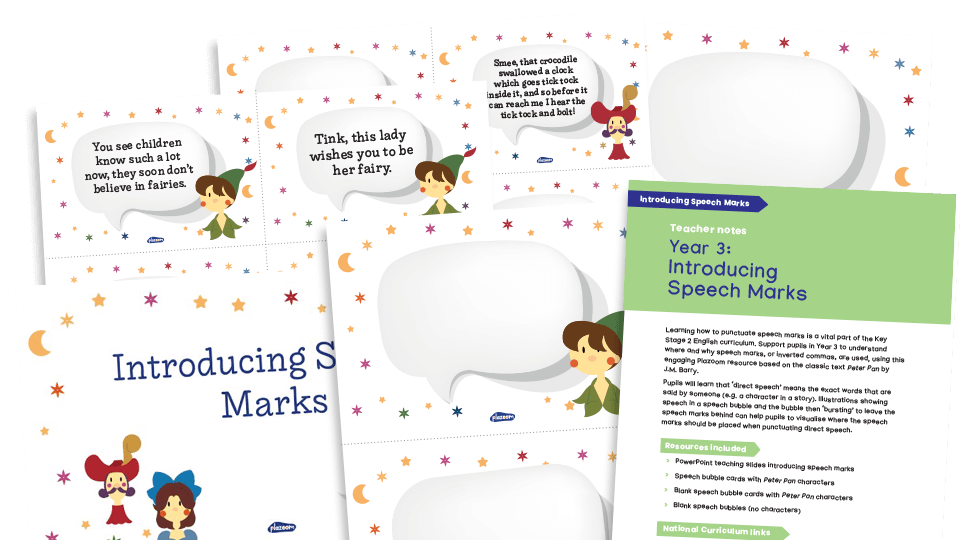
Alternatively, this Year 3 Real Grammar pack introduces pupils to using inverted commas to punctuate direct speech, with teaching slides, differentiated worksheets, games, writing tasks and SATs-style questions to build accuracy and confidence.
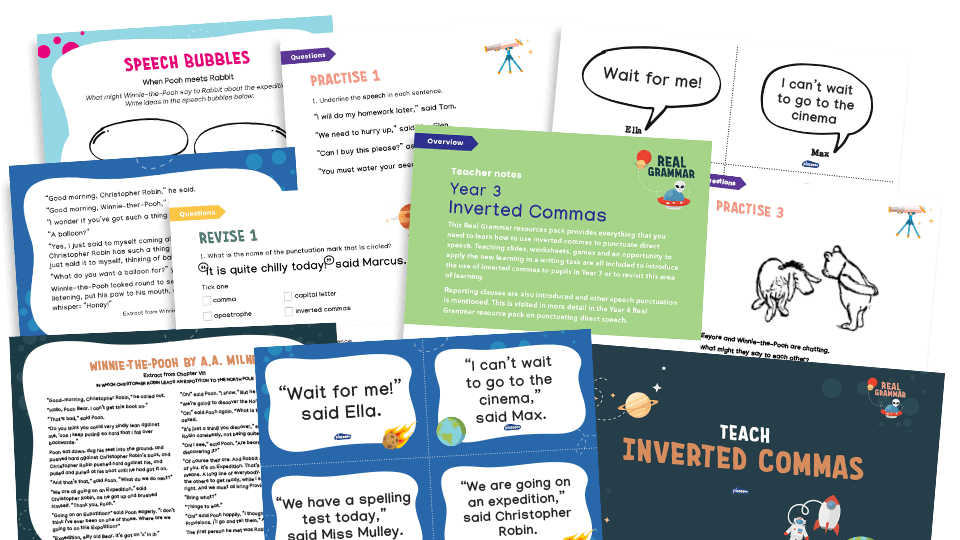
This Year 3 Grammar Burst resource pack provides a complete five-lesson sequence with teaching slides, activities and writing tasks to help pupils master using inverted commas and apply their skills in extended writing.
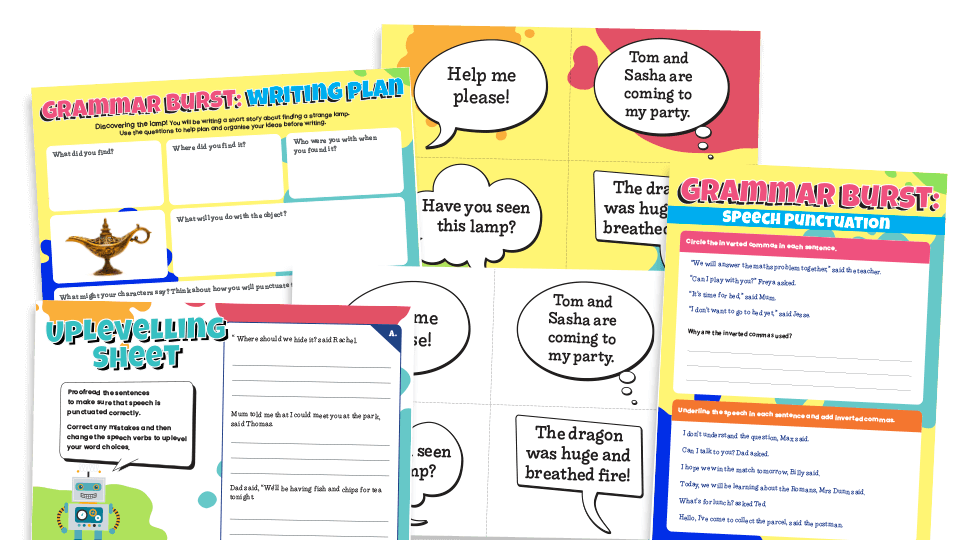
Meanwhile, our Year 4 Grammar Burst pack for punctuating direct speech offers a five-lesson sequence with PowerPoints, worksheets, story-based activities and writing plans.
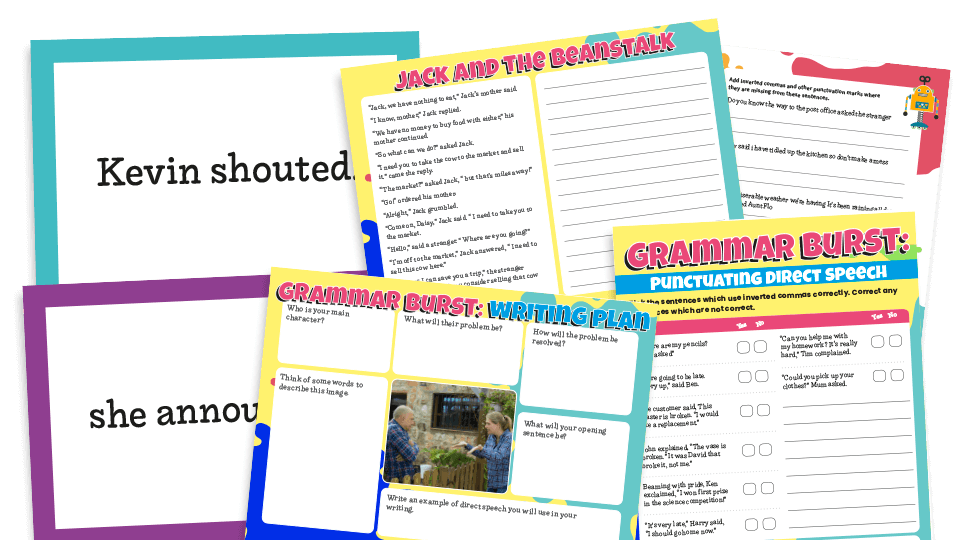
Building on Y3 knowledge, this Year 4 Real Grammar pack revisits inverted commas and introduces the wider range of punctuation needed for direct speech, while also guiding pupils in writing longer pieces of dialogue through interactive lessons, practice activities and differentiated tasks.
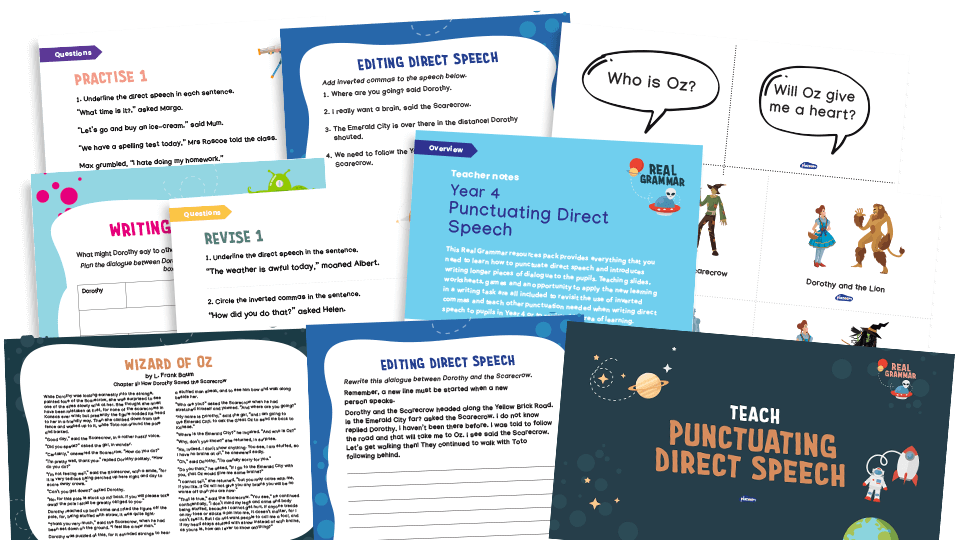
Our LKS2 direct speech and inverted commas challenge mats from our SPaG Gym collection help KS2 pupils practise punctuation, improve their writing and build confidence with fun, engaging exercises.
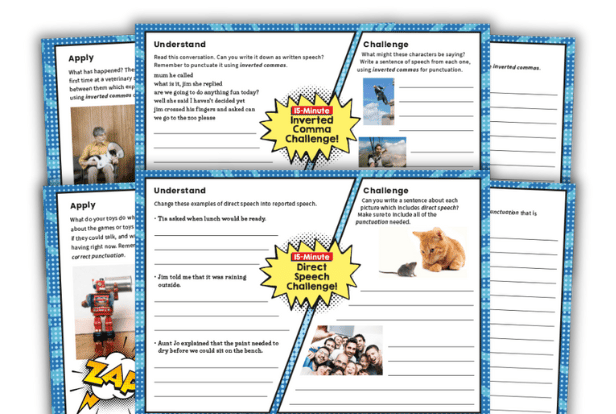
This Year 3-4 Sentence Builder game helps pupils practise using speech marks and direct speech through interactive sentence creation, oral rehearsal and grammar discussion. It's suitable for whole-class lessons or targeted writing support.
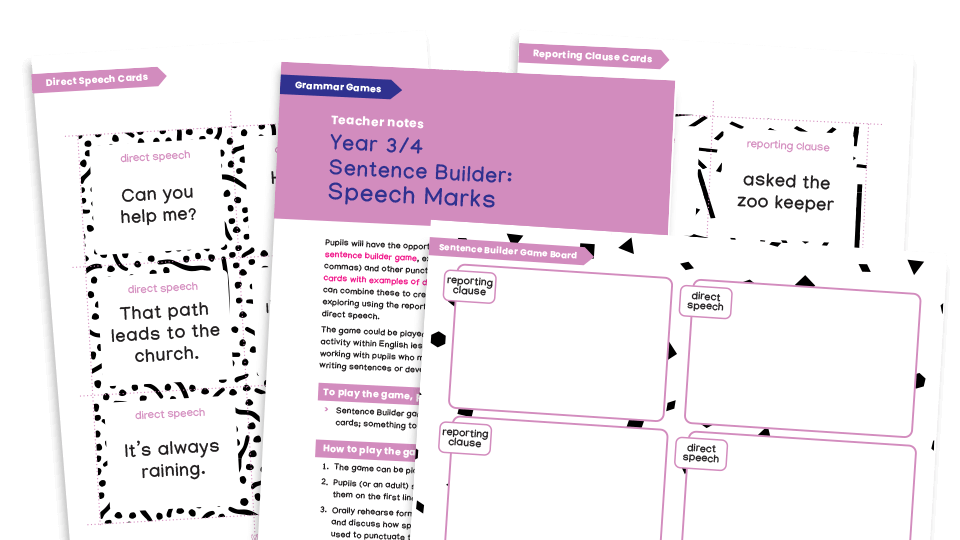
Year 6 revision
This Year 6 SPaG Revision Blaster pack helps pupils review and practise punctuating direct speech in line with the KS2 GPS test framework, with recap slides, SATs-style worksheets of increasing difficulty and answer sheets for independent or whole-class revision.
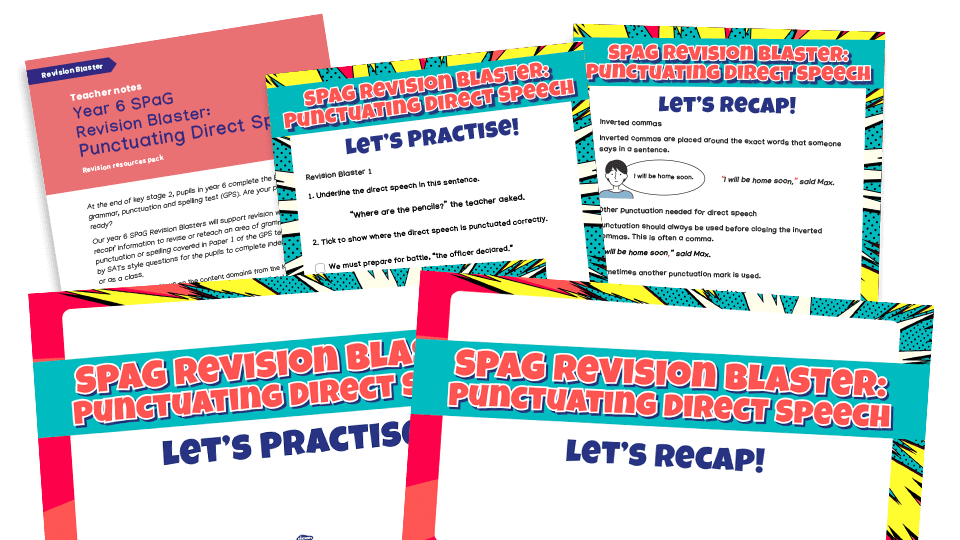
Reported speech
When you describe what someone has said without directly quoting them, we call this reported speech. Journalists frequently use this. A simplistic way of explaining it is that you use that instead of putting the speech in inverted commas and adapt the language accordingly.
For example:
Direct speech: Dina said, “My friend told me to do it.”
Reported speech: Dina said that her friend had told her to do it.
Reported speech is not a specified requirement at KS2. However, it’s useful for pupils to know about it and when they can use it.
Quotation marks – Learning by checking
When KS2 pupils are learning how to punctuate direct speech, it will help if you break your assessment criteria into all the constituent parts.
For example, you could have a checklist that separately itemises the use of inverted commas, capitals, commas and so on.
The requirement in KS2 English is that we use speech to convey character and advance the action. For this reason, you should encourage pupils to avoid tiresome and inconsequential exchanges that contribute nothing to the plot.
Composing and integrating dialogue is a skill in itself. Even so, you can diminish or lose the impact altogether if you’re unable to punctuate it properly.
No one’s saying that it is easy but, hopefully, these ideas might help you say, “I feel more confident about teaching speech punctuation now.”
Sue Drury qualified as a primary teacher in 1999. Teaching pupils from Year 1 to Year 8, she has held a variety of positions including maths and English subject leader, year leader, and assistant headteacher. Sue has mentored students and NQTs, offering guidance and advice using her years of experience. She created many of Plazoom's literacy resources.